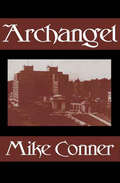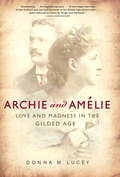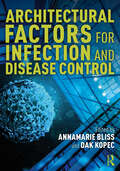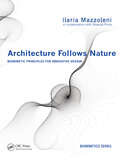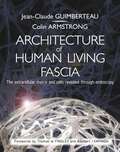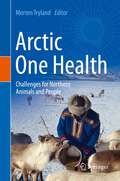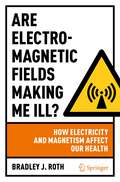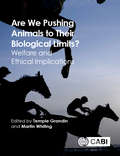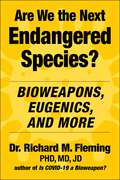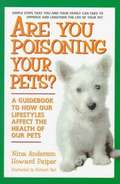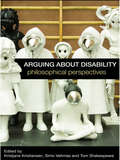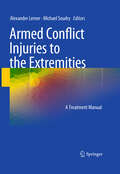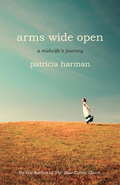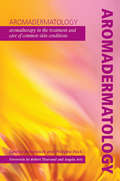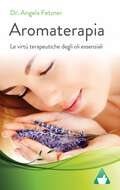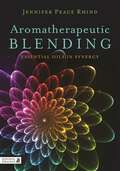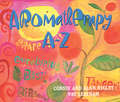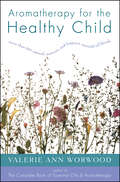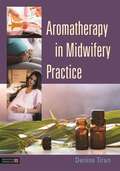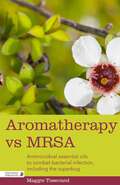- Table View
- List View
Archaeology and the Senses
by Yannis HamilakisThis book is an exciting new look at how archaeology has dealt with the bodily senses and offers an argument for how the discipline can offer a richer glimpse into the human sensory experience. Yannis Hamilakis shows how, despite its intensely physical engagement with the material traces of the past, archaeology has mostly neglected multi-sensory experience, instead prioritizing isolated vision and relying on the Western hierarchy of the five senses. In place of this limited view of experience, Hamilakis proposes a sensorial archaeology that can unearth the lost, suppressed, and forgotten sensory and affective modalities of humans. Using Bronze Age Crete as a case study, Hamilakis shows how sensorial memory can help us rethink questions ranging from the production of ancestral heritage to large-scale social change, and the cultural significance of monuments. Tracing the emergence of palaces in Bronze Age Crete as a celebration of the long-term, sensuous history and memory of their localities, Hamilakis points the way to reconstituting archaeology as a sensorial and affective multi-temporal practice. At the same time, he proposes a new framework on the interaction between bodily senses, things, and environments, which will be relevant to scholars in other fields.
Archangel
by Mike ConnerNebula-award winning author Mike Conner presents a novel about a world that all of us can recognize, a world of what might have been. In Minneapolis in the 1930&’s, the deadly plague that ended the First World War is decimating the population. The only people who seem to be immune to its effects are black people. What does this mean for the future of the city—and of the nation? Young newsman Danny Constantine finds that not everyone is dying from the plague. He has discovered a series of bizarre deaths—murders that look like the work of a vampire. In these times of bad news, his own paper refuses to print the story and Danny must search for the truth on his own, except for a mysterious woman known only as archangel, who always seems to appear when needed most.
Archie and Amelie: Love and Madness in the Gilded Age
by Donna M. LuceyFilled with glamour, mystery, and madness, Archie and Amélie is the true story chronicling a tumultuous love affair in the Gilded Age. John Armstrong "Archie" Chanler was an heir to the Astor fortune, an eccentric, dashing, and handsome millionaire. Amélie Rives, Southern belle and the goddaughter of Robert E. Lee, was a daring author, a stunning temptress, and a woman ahead of her time. Archie and Amélie seemed made for each other—both were passionate, intense, and driven by emotion—but the very things that brought them together would soon tear them apart. Their marriage began with a “secret” wedding that found its way onto the front page of the New York Times, to the dismay of Archie’s relatives and Amélie’s many gentleman friends. To the world, the couple appeared charmed, rich, and famous; they moved in social circles that included Oscar Wilde, Teddy Roosevelt, and Stanford White. But although their love was undeniable, they tormented each other, and their private life was troubled from the start. They were the F. Scott and Zelda Fitzgerald of their day—a celebrated couple too dramatic and unconventional to last—but their tumultuous story has largely been forgotten. Now, Donna M. Lucey vividly brings to life these extraordinary lovers and their sweeping, tragic romance. “In the Virginia hunt country just outside of Charlottesville, where I live, the older people still tell stories of a strange couple who died some two generations ago. The stories involve ghosts, the mysterious burning of a church, a murder at a millionaire’s house, a sensational lunacy trial, and a beautiful, scantily clad young woman prowling her gardens at night as if she were searching for something or someone—or trying to walk off the effects of the morphine that was deranging her. I was inclined to dismiss all of this as tall tales Virginians love to spin out; but when I looked into these yarns I found proof that they were true. . . .” —Donna M. Lucey on Archie and Amélie
Archie and Amelie: Love and Madness in the Gilded Age
by Donna M. LuceyFilled with glamour, mystery, and madness, Archie and Amélie is the true story chronicling a tumultuous love affair in the Gilded Age. John Armstrong "Archie" Chanler was an heir to the Astor fortune, an eccentric, dashing, and handsome millionaire. Amélie Rives, Southern belle and the goddaughter of Robert E. Lee, was a daring author, a stunning temptress, and a woman ahead of her time. Archie and Amélie seemed made for each other—both were passionate, intense, and driven by emotion—but the very things that brought them together would soon tear them apart. Their marriage began with a “secret” wedding that found its way onto the front page of the New York Times, to the dismay of Archie’s relatives and Amélie’s many gentleman friends. To the world, the couple appeared charmed, rich, and famous; they moved in social circles that included Oscar Wilde, Teddy Roosevelt, and Stanford White. But although their love was undeniable, they tormented each other, and their private life was troubled from the start. They were the F. Scott and Zelda Fitzgerald of their day—a celebrated couple too dramatic and unconventional to last—but their tumultuous story has largely been forgotten. Now, Donna M. Lucey vividly brings to life these extraordinary lovers and their sweeping, tragic romance. “In the Virginia hunt country just outside of Charlottesville, where I live, the older people still tell stories of a strange couple who died some two generations ago. The stories involve ghosts, the mysterious burning of a church, a murder at a millionaire’s house, a sensational lunacy trial, and a beautiful, scantily clad young woman prowling her gardens at night as if she were searching for something or someone—or trying to walk off the effects of the morphine that was deranging her. I was inclined to dismiss all of this as tall tales Virginians love to spin out; but when I looked into these yarns I found proof that they were true. . . .” —Donna M. Lucey on Archie and Amélie
Architectural Factors for Infection and Disease Control
by Dak Kopec AnnaMarie BlissThis edited collection explores disease transmission and the ways that the designed environment has promoted or limited its spread. It discusses the many design factors that can be used for infection and disease control through lenses of history, public health, building technology, design, and education. This book calls on designers to consider the role of the built environment as the primary source of bacterial, viral, and fungal transfers through fomites, ventilation systems, and overcrowding and spatial organization. Through 19 original contributions, it provides an array of perspectives to understand how the designed environment may offer a reprieve from disease. The authors build a historical foundation of infection and disease, using examples ranging from lazarettos to leprosy centers to show how the ability to control infection and disease has long been a concern for humanity. The book goes on to discuss disease propagation, putting forth a variety of ideas to control the transmission of pathogens, including environmental design strategies, pedestrian dynamics, and open space. Its final chapters serve as a prospective way forward, focusing on COVID-19 and the built environment in a post-pandemic world. Written for students and academics of architecture, design, and urban planning, this book ignites creative action on the ways to design our built environment differently and more holistically. Please note that research on COVID-19 has exponentially grown since this volume was written in October 2020. References cited reflect the evolving nature of research studies at that time.
Architectural Factors for Infection and Disease Control
by Dak Kopec AnnaMarie BlissThis edited collection explores disease transmission and the ways that the designed environment has promoted or limited its spread. It discusses the many design factors that can be used for infection and disease control through lenses of history, public health, building technology, design, and education.This book calls on designers to consider the role of the built environment as the primary source of bacterial, viral, and fungal transfers through fomites, ventilation systems, and overcrowding and spatial organization. Through 19 original contributions, it provides an array of perspectives to understand how the designed environment may offer a reprieve from disease. The authors build a historical foundation of infection and disease, using examples ranging from lazarettos to leprosy centers to show how the ability to control infection and disease has long been a concern for humanity. The book goes on to discuss disease propagation, putting forth a variety of ideas to control the transmission of pathogens, including environmental design strategies, pedestrian dynamics, and open space. Its final chapters serve as a prospective way forward, focusing on COVID-19 and the built environment in a post-pandemic world.Written for students and academics of architecture, design, and urban planning, this book ignites creative action on the ways to design our built environment differently and more holistically.Please note that research on COVID-19 has exponentially grown since this volume was written in October 2020. References cited reflect the evolving nature of research studies at that time.
Architecture Follows Nature-Biomimetic Principles for Innovative Design (Biomimetics Series)
by Ilaria MazzoleniThis full-color volume proposes an innovative methodology that uses the functional aspects of nature to inspire improvements in building design and form, encouraging designers to apply biomimetic principles to architectural processes. The book focuses on the analysis of various animal skins, translating the principles of communication, thermoregulation, water balance, and protection into the built environment. Illustrating how biomimetic principles can create a more sustainable way of building, this is the first time the author's new methodology-as well as the 12 case studies-has been published.
Architecture of Human Living Fascia: The Extracellular Matrix and Cells Revealed Through Endoscopy
by Jean Claude Guimberteau Colin ArmstrongThis unique book illustrates the structure of the fascia in the living human being. Dr Guimberteau's photographs provide a detailed account of fascial architecture. The accompanying text explains what the photographs mean, clarifies the importance of the fascia, and sets out the implications of these findings for everyday therapeutic practice.This beautifully illustrated book provides an introduction to Dr Guimberteau's groundbreaking work. He is the first person to publish video "movies" showing the structure of the fascia and how the fascia responds to. Based on what can be seen he has developed his own concept of the multifibrillar structural organisation of the body, wherein the "microvacuole" is the basic functional unit. His films confirm the continuity of fibres throughout the body thereby seeming to confirm the tensegrity theory, which provides the basis of many manual therapy and bodywork teachings. His work ties in with that of Donald Ingber on tensegrity within the cytoskeleton, and adds to the evidence linking the cytoskeleton to the extracellular matrix as described by james Oschman. The book and videos provide, for the first time, an explanatory introduction and explanation of these theories and link them to the visual evidence shown in the video. This material will be highly valued by osteopaths, massage therapists, chiropractors and others as it provides part of the scientific underpinning of their techniques, as well as an explanation of what is happening when they use those techniques to treat their clients.So Guimberteau's material confirms what manual therapists already believed but didn't fully understand. He has provided an explanation of how fascial layers slide over each other and how adjacent structures can move independently in different directions and at different speeds while maintaining the stability of the surrounding tissues.
Archiving Medical Violence: Consent and the Carceral State
by Christopher PerreiraA major new reading of a U.S. public health system shaped by fraught perceptions of culture, race, and criminality At the heart of Archiving Medical Violence is an interrogation of the notions of national and scientific progress, marking an advance in scholarship that shows how such violence is both an engine of medical progress and, more broadly, the production of empire. It reads the medical archive through a lens that centers how it is produced, remembered, and contested within cultural production and critical memory. In this innovative and interdisciplinary book, Christopher Perreira argues that it is in the contradictions of settler colonialism and racial capitalism that we find how medical violence is narrated as a public good. He presents case studies from across a range of locations—Hawai&‘i, California, Louisiana, Guatemala—and historical periods from the nineteenth century on. Examining national and scientific conceptions of progress through the lens of medicine and public health, he places official archives in dialogue with visual and literary works, patient writing, and more. Archiving Medical Violence explores the contested public terrains for narrating value and vulnerabilities, bodies and geographical locations. Ultimately, Perreira reveals for us a medical imaginary built on racialized criminality driving contemporary politics of citizenship, memory, and identity. Retail e-book files for this title are screen-reader friendly with images accompanied by short alt text and/or extended descriptions.
Arctic One Health: Challenges for Northern Animals and People
by Morten TrylandThis multidisciplinary book discusses the manifold challenges arctic marine and terrestrial wildlife, ecosystems and people face these times. Major health threats caused by the consequences of climate change, environmental pollution and increasing tourism in northern regions around the globe are explored. The most common infectious diseases in wild and domesticated arctic animals are reviewed and the impact they could have on circumpolar ecosystems as well as on the lives of arctic people are profoundly discussed. Moreover, the book reviews arctic hunting, herding and food conservation strategies and introduces veterinary medicine in remote indigenous communities. "Arctic One Health" is authored by experts based in arctic regions spanning from North America over Europe to Asia to cover a broad range of topics and perspectives. The book addresses researchers in Veterinary Medicine, Ecology, Microbiology and Anthropology. The book contributes towards achieving the UN Sustainable Developmental Goals, in particular SDG 15, Life on Land.
Are Electromagnetic Fields Making Me Ill?: How Electricity and Magnetism Affect Our Health
by Bradley J. RothElectricity and Magnetism (E&M) underlies many lifesaving medical devices, such as magnetic resonance imaging scanners, neural stimulators, and heart pacemakers. But E&M also attracts its share of bogus health claims, such as biomagnetic therapy. How do you separate the good from the bad? Sometimes it’s not easy: experiments are prone to artifacts, theories are limited by assumptions, and clinical trials can result in ambiguities. In this book, the author separates the wheat from the chaff, showing which applications of E&M are bogus and which are not. This book takes the reader on a tour through a range of fascinating phenomena, from effects that are constant in time at one extreme, such as transcranial direct current stimulation of the brain, to the millimeter-wave whole-body scanners which are familiar to frequent flyers at the other. Along the way, the author looks in depth at the dispute about power line magnetic fields and leukemia, a case study in what can go wrong when dubious claims inflame unjustified fears. The debate about cell phones and brain cancer still rages today, particularly for the microwave frequencies encountered with new 5G technology. Recently, the so-called Havana Syndrome has been attributed to microwave weapons, but the underlying biophysics of such weapons is unclear. For all these encounters with electricity and magnetism, the author, an eminent biophysicist, uses science and evidence to sort out fact from fantasy. This book is aimed at general readers who want to make sense of the mysterious and often controversial ways in which E&M interacts with the human body. It is also ideal for students and professionals in bioscience and health-related fields who want to learn more without getting overwhelmed by theory.
Are We Pushing Animals to Their Biological Limits?: Welfare and Ethical Implications
by Temple Grandin Martin WhitingStimulating and thought-provoking, this important new text looks at the welfare problems and philosophical and ethical issues that are caused by changes made to an animal's telos, behaviour and physiology, both positive and negative, to make them more productive or adapted for human uses. These changes may involve selective breeding for production, appearance traits, or competitive advantage in sport, transgenic animals or the use of pharmaceuticals or hormones to enhance production or performance. Changes may impose duties to care for these animals further and more intensely, or they may make the animal more robust. The book considers a wide range of animals, including farm animals, companion animals and laboratory animals. It reviews the ethics and welfare issues of animals that have been adapted for sport, as companions, in work, as ornaments, food sources, guarding and a whole host of other human functions. This important new book sparks debate and is essential reading for all those involved in animal welfare and ethics, including veterinarians, animal scientists, animal welfare scientists and ethologists.
Are We the Next Endangered Species?: Bioweapons, Eugenics, and More
by Dr. Richard M. FlemingAre We the Next Endangered Species? unravels the complex web of historical events, misinformation, and the ominous convergence of bioweapons and eugenics In this thought-provoking new book, Dr. Fleming challenges us to navigate the murky waters of history, exposing parallel programs developed over the last 170 years in the United States. This riveting exploration unearths ancient civilizations that embraced slavery, sterilization, and eugenics, drawing chilling parallels to our present reality. Dr. Fleming confronts the uncomfortable truth: are we repeating the mistakes of the past while expecting different outcomes? Are we destined to replicate the errors that led to the rise of powerful individuals and organizations seeking ultimate control over others? Key revelations include the stealthy usurpation of power in the United States since the 1850s, the nation's pivotal role in developing biological and chemical weapons, and its shocking collaboration with Nazi scientists, doctors, and intelligence officers. Dr. Fleming unveils the shadowy world of covert operations, the establishment of the military-industrial complex, and the surrender of medical control to the federal government. Readers will discover the intricate pathways of biowarfare and eugenics converging with the emergence of COVID. They will learn about the gain-of-function bioweapons responsible for the pandemic and the parallel development of eugenic genetic vaccines. Fleming reveals the control wielded by the military-industrial complex and world leaders over your life, movement, property, and freedoms. This book is not just an exploration of the past or a revelation of how those in power are on the brink of realizing their ultimate control, it's a call to action. It doesn't just raise awareness—it empowers readers to understand, question, and take decisive action to halt the ominous path we're on. In a world where truth is elusive and power is coveted, this book is a beacon of knowledge, urging you to discover what you can do to stop the impending threats to our existence. The future hangs in the balance and Are We the Next Endangered Species? provides the roadmap to safeguard it.
Are You Poisoning Your Pets?
by Nina Anderson Howard PeiperAre You Poisoning Your Pets delves into the many issues that can arise for our animals with the commonly used products on the market today for cleaning, household repair, even for how we approach fleas and other pests-- a must read if you want to keep your pet healthy and happy for years to come.
Arguing about Disability: Philosophical Perspectives
by Tom Shakespeare Kristjana Kristiansen Simo VehmasDisability is a thorny and muddled concept - especially in the field of disability studies - and social accounts contest with more traditional biologically based approaches in highly politicized debates. Sustained theoretical scrutiny has sometimes been lost amongst the controversy and philosophical issues have often been overlooked in favour of the sociological. Arguing about Disability fills that gap by offering analysis and debate concerning the moral nature of institutions, policy and practice, and their significance for disabled people and society. This pioneering collection is divided into three sections covering definitions and theories of disability; disabled people in society and applied ethics. Each contributor – drawn from a wide range of academic backgrounds including disability studies, sociology, psychology, education, philosophy, law and health science – uses a philosophical framework to explore a central issue in disability studies. The issues discussed include personhood, disability as a phenomenon, social justice, discrimination and inclusion. Providing an overview of the intersection of disability studies and philosophical ethics, Arguing about Disability is a truly interdisciplinary undertaking. It will be invaluable for all academics and students with an interest in disability studies or applied ethics, as well as disability activists.
Armed Conflict Injuries to the Extremities: A Treatment Manual
by Alexander Lerner Michael SoudryThis book is designed to meet the continued need to re-learn the principles of treatment of complex war injuries to the extremities in order to minimize post-traumatic and post-treatment complications and optimize functional recovery. Most of the chapters are based on the unique experience gained in the treatment of military personnel who have suffered modern combat trauma and civilian victims of terror attacks at a single, large level 1 trauma center. The remaining chapters present the experience of leading international authorities in trauma and reconstructive surgery. A staged treatment protocol is presented, ranging from primary damage control through to definitive functional limb reconstruction. The organization of medical aid, anesthesiology, diagnostic imaging, infection prophylaxis, and management of complications are reviewed, and a special chapter is devoted to the challenging dilemma of limb salvage versus amputation in the treatment of limbs at risk.
Arms Wide Open
by Patricia HarmanA midwife's memoir of living free and naturally against all oddsIn her first, highly praised memoir, Patricia Harman told us the stories patients brought into her exam room, and her own story of struggling to help women as a nurse-midwife in medical practice with her husband, an OB/GYN, in Appalachia. In this new book, Patsy reaches back to tell us how she first learned to deliver babies, and digs even deeper down to tell us of her youthful experiments with living a fully sustainable and natural life.Drawing heavily on her journals, Arms Wide Open goes back to a time of counter-culture idealism that the boomer generation remembers well. Patsy opens with stories of living in the wilds of Minnesota in a log cabin she and her lover build with their own hands, the only running water being the nearby streams. They set up beehives and give chase to a bear competing for the honey. Patsy gives birth and learns to help her friends deliver as naturally as possible.Weary of the cold and isolation, Patsy moves to a commune in West Virginia, where she becomes a self-taught midwife delivering babies in cabins and homes. Her stories sparkle with drama and intensity, but she wants to help more women than healthy hippie homesteaders. After a ten-year sojourn for professional training, Patsy and her husband, Tom, return to Appalachia, as a nurse-midwife and physician, where they set up a women's-health practice. They deliver babies together, this time in hospitals; care for a wide variety of gyn patients; and live in a lakeside contemporary home--but their hearts are still firmly implanted in nature. The obstetrical climate is changing. The Harmans' family is changing. The earth is changing, but Patsy's arms remain wide open to life and all it offers.Her memoir of living free and sustainably against all odds will be especially embraced by anyone who lived through the Vietnam War and commune era, and all those involved in the back-to-nature and natural-childbirth movements.
Aromadermatology: Aromatherapy in the Treatment and Care of Common Skin Conditions
by Janetta Bensouilah Philippa BuckThis comprehensive, evidence-based guide promotes an integrative approach to using complementary therapies with conventional medicines. It increases awareness of the sound scientific basis to aromatherapy with a wealth of data, and contains practical information for treatment. Contents include: Skin structure and function * Essential oil sciences in context * Aromadermatology and safety issues * The essentials of aromatic formulations * Skin-care essentials * Skin and the psyche * Skin infections * Childhood skin complaints * Inflammatory disorders * Wound care * Nails, hair and sebaceous glands ‘With the growing interest in aromatherapy, it is important that therapists and healthcare professionals are able to offer a valid rationale when integrating essential oils into clinical care. Sound knowledge of bio-chemical principles and the ability to critically appraise and apply relevant research are fundamental requirements. This book offers a comprehensive, in-depth view of current knowledge. The authors have skilfully woven research and clinical application. A range of therapeutic possibilities is explored and offers practitioners alternative approaches to the management of skin conditions. These include detailed discussions on different methods of application. I hope that this book will become a standard text on both pre-qualifying and CPD courses in aromatherapy.’ – Angela Avis, in her Foreword ‘This well-illustrated, thorough and authoritative text is written in a language and style that is clear and accessible to a variety of healthcare practitioners. A thorough understanding of dermatology underpins the book, and both current research and clinical knowledge are elegantly applied to the skin conditions discussed.’ – Robert Tisserand, in his Foreword
Aromaterapia: Le virtù terapeutiche degli oli essenziali
by Dr Angela FetznerLe virtù terapeutiche degli oli essenziali ci permettono di contribuire in modo molto gradevole alla nostra salute psichica e fisica. Infatti, il profumo benefico degli oli essenziali può influenzare il nostro umore e avere un effetto positivo sul nostro stato d’animo e sul nostro corpo. L'aromaterapia impiega gli oli essenziali, avvalendosi delle loro proprietà, per ottenere determinati effetti. L'energia terapeutica e la forza vitale concentrata delle sostanze naturali garantiscono armonia, equilibrio e salute duratura. Care lettrici e cari lettori, vorrei invitarvi ad accompagnarmi in un interessante viaggio nel mondo degli oli essenziali. L’autrice, che ha conseguito il dottorato in Storia della Farmacia (Dr. rer. Nat.), assiste e informa numerosi clienti da più di vent’anni. In qualità di autrice indipendente e farmacista, l'autrice di questo libro si impegna esclusivamente per la salute e il benessere delle persone. Confrontate il numero di pagine e la qualità prima di acquistare un e-book o un libro in formato tascabile. - Utilizzate la funzione anteprima. Questo libro, nel formato tascabile, conta 120 pagine reali ed è stato scritto da un’esperta, a differenza dei testi di 20 o 30 pagine realizzati da autori fittizi tramite il copia e incolla da Internet.
Aromatherapeutic Blending: Essential Oils in Synergy
by Jennifer Peace RhindSynergistic blending is at the very core of aromatherapy practice. This book explores the concept of synergy and the evidence for its presence and significance, and provides practical guidance on how to build aromatherapeutic blends effectively and safely based on research evidence. The author covers new and exciting developments in research into the use of essential oils, explores the merits and limitations of holistic, psychosensory and molecular approaches to blending and suggests effective ways of choosing the most suitable approach for individual clients. Evidence-based profiles of essential oils and absolutes are included and the comprehensive tables summarising their actions enable practitioners to identify easily potential contenders for synergistic blends. Throughout the book, the author encourages students and practitioners of all levels to reflect on their practice, appraising the intended outcomes of their blends and treatment plans, so that they can emerge more knowledgeable and insightful practitioners.
Aromatherapy A-Z (Hay House Lifestyles Ser.)
by Connie Higley Alan Higley Pat LeathamHerbs have been used from the time of recorded history for every facet of life-health, healing, energy, creativity, work, love, birth, death, regeneration, meditation, survival, and more. They are all-encompassing and timeless, as nature itself is infinite and eternal. Therapeutic herbs have a unique spirit, with wide-ranging properties and far-reaching possibilities for medicinal activity.
Aromatherapy for the Healthy Child: More Than 300 Natural, Nontoxic, and Fragrant Essential Oil Blends
by Valerie Ann WorwoodAromatherapy taps the healing potential of Earth's ancient medicines, the essential oils that give plants their scent. Powerful yet safe, aromatherapy is a sound way to treat everything from diaper rash to asthma to self-esteem troubles in children. Many complaints such as aches and coughs that might otherwise have to wait for a visit to the doctor can be addressed immediately at home using the healing power of nature.This book will appeal to every parent who thinks proactively about their children's long-term physical and mental health. Valerie Ann Worwood offers an array of scientifically proven remedies, along with complete charts of essential oils and instructions for aromatherapeutic massage. Other chapters describe how aromatherapy can benefit seriously ill children when used in conjunction with Western medicine.
Aromatherapy in Midwifery Practice
by Denise TiranAromatherapy is increasingly incorporated into midwifery practice, particularly in midwife-led units. It is the most commonly used therapy by midwives and birthing practitioners but access to up-to-date safety information is limited. Almost 90% of women may be using complementary therapies during pregnancy and birth and so it is very important that midwives are aware of safe and appropriate use based on contemporary evidence. This book covers safety, effectiveness, evidence, benefits and risks, and legal, ethical and professional issues related to incorporating aromatherapy into maternity care. Useful charts and tables are included for quick reference in clinical practice, making this is the ultimate handbook for using aromatherapy in midwifery practice. The scientific basis behind aromatherapy, including relevant anatomy and physiology, chemistry and pharmacology are covered, as well as a critical appraisal of the contemporary research evidence supporting the use of aromatherapy in maternity care. Essential oil profiles of the oils that can be safely used in pregnancy, birth and postnatally are also included.
Aromatherapy vs MRSA: Antimicrobial essential oils to combat bacterial infection, including the superbug
by Maggie TisserandAddressing the challenge of serious infection, especially MRSA, in hospitals, in the community, and in animals, Maggie Tisserand focuses on the scientifically proven effects of antibacterial essential oils, and their usefulness in managing infection, including the 'superbug'. She profiles the key essential oils - tea tree, manuka and thyme - covering everything from habitat, chemistry and commercial uses to the latest scientific research that proves their effectiveness against bacterial infection, and how they should be used. She also includes information about other methods that have been shown to help with the management of acute infection, including allicin from garlic, silver, manuka honey and phage therapy. Breaking new ground in the field of essential oils, this scientifically based but accessible book will be essential reading for aromatherapists, health professionals and everyone interested in effective ways in which to combat infection and stay healthy. With the increase in antibiotic-resistant bacteria and the danger of bacteria staying alive on surfaces and clothing, it is in the interests of every therapist and practitioner to be aware of these threats and instigate preventative measures.
Aromatherapy, Massage and Relaxation in Cancer Care: An Integrative Resource for Practitioners
by Graeme Donald Timothy Jackson Dr Jacqui Stringer Paula Maycock Reverend Kevin Dunn Lydia Nightingale Debs Costello Gwynneth Campbell Lynne Tomlinson Anita Mehrez Anne Cawthorn Dr Peter Mackereth Rebecca Knowles Ann CarterAromatherapy, massage and relaxation are three of the most commonly used therapies in cancer care. This book offers an integrated approach to using these therapies and provides an evidence-based foundation for complementary therapists working in cancer care settings. International in its scope, the book provides essential information about the ethical and professional context in which therapists can practice and vital facts regarding medical treatment and potential side effects.

